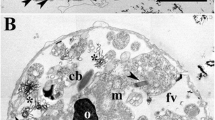Abstract
Epibiontic cells on the surface of the photosynthetic purple sulfur bacteriumChromatium minus, collected several times during the year from 3 different Spanish lakes, were examined using scanning and transmission electron microscopy. The cells attached to theC. minus cell wall by an electron-dense pad, but did not enter the cell. They were ovoidal (about 0.6Μm wide) when free, and slightly curved rods (0.3×0.6Μm) when undergoing division. Division only occurred when cells remained attached toChromatium. A septum was formed, resulting in 2 or 3 curved rods surrounded by a common capsule. Detached daughter cells became ovoidal.
The host ultrastructure changed as a result of epibiontic attachment, showing symptoms of cellular degradation. Simultaneously, plaques could be detected on cell lawns formed spontaneously upon cell sedimentation from field samples.
Similar content being viewed by others
References
Abeliovich A, Kaplan S (1974) Bacteriophages ofRhodopseudomonas sphaeroides: Isolation and characterization of aRhodopseudomonas sphaeroides bacteriophage. J Virol 13:1392–1399
Anderson TF (1951) Techniques for the preservation of three-dimensional structure in preparing specimens for the electron microscope. Trans NY Acad Sci 13:130–135
Burnham JC, Hashimoto T, Conti SF (1968) Electron microscopic observations on the penetration ofBdellovibrio bacteriovorus into Gram-negative bacterial hosts. J Bacteriol 96:1366–1381
Coder DM, Starr MP (1978) Antagonistic association of the chlorellavorus bacterium (“Bdellovibrio” chlorellavorus) withChlorella vulgaris. Current Microbiology 1:59–64
Freund-Molbert E, Drews G, Bosecker K, Schubel B (1968) Morphologie und Wirtskreis eines neu isoliertenRhodopseudomonas palustris-phagen. Arch Mikrobiol 64:1–8
Gromov BV, Mamkayeva KA (1972) Electron microscopic examination ofBdellovibrio chlorellavorus parasitism on cells of the green algaChlorella vulgaris. Tsitologiya 14:256–260 (In Russian)
Gromov BV, Mamkayeva KA (1980) Proposal of a new genusVampirovibrio for chlorellavorus bacteria previously assigned toBdellovibrio. Mikrobiologya 49:165–167 (In Russian)
Guerrero R, Montesinos E, Esteve I, Abellà C (1980) Physiological adaptation and growth of purple and green sulfur bacteria in a meromictic lake (Vilar) as compared to a holomictic lake (Sisó). In: Dokulil M, Metz H, Jewson D (eds) Shallow lakes. Developments in hydrobiology, Vol 3. W Junk Publishers, The Hague, pp 161–171
Huang JC, Starr MP (1973) Possible enzymatic bases of bacteriolysis by bdellovibrios. Arch Microbiol 89:147–167
Kessel M, Shilo M (1976) Relationship ofBdellovibrio elongation and fission to host cell size. J Bacteriol 128:477–480
Larkin JM (1980) Isolation ofThiothrix in pure culture and observation of a filamentous epiphyte onThiothrix. Current Microbiology 4:155–158
Paerl HW (1976) Specific associations of the bluegreen algaeAnabaena andAphanizomenon with bacteria in freshwater blooms. J Phycol 12:431–435
Reynolds ES (1963) The use of lead citrate at high pH as an electron-opaque stain in electron microscopy. J Cell Biol 17:208–212
Rittenberg SC, Shilo M (1970) Early host damage in the infection cycle ofBdellovibrio bacteriovorus. J Bacteriol 102:149–160
Ryter A, Kellenberger E, Sechaud J (1958) Electron microscope study of DNA-containing plasms. II. Vegetative and mature phage DNA as compared with normal bacterial nucleoids in different physiological states. J Biophys Biochem Cytol 4:671–682
Schmidt LS, Men HC, Gest H (1974) Bioenergetic aspects of bacteriophage replication in the photosynthetic bacteriumRhodopseudomonas capsulata. Arch Biochem Biophys 165: 229–239
Stolp H, Petzold H (1962) Untersuchungen über einen obligat parasitischen Microorganismus mit lytischer AktivitÄt fürPseudomonas-Bakterien. Phytopathol Zeitschrift 45:364–390
Stolp H (1973) The bdellovibrios: bacterial parasites of bacteria. Annu Rev Phytopathol 11:53–76
Tudor JJ, Conti SF (1977) Characterization of bdellocysts ofBdellovibrio sp. J Bacteriol 131:314–322
Tudor JJ, Conti SF (1977) Ultrastructural changes during encystment and germination ofBdellovibrio sp. J Bacteriol 131:323–330
Van Gemerden H (1980) Survival ofChromatium vinosum at low light intensities. Arch Microbiol 125:115–121
Wall JD, Wearer PF, Gest H (1975) Gene transfer agents, bacteriophages, and bacteriocins ofRhodopseudomonas capsulata. Arch Microbiol 105:217–222
Author information
Authors and Affiliations
Rights and permissions
About this article
Cite this article
Esteve, I., Guerrero, R., Montesinos, E. et al. Electron microscope study of the interaction of epibiontic bacteria withChromatium minus in natural habitats. Microb Ecol 9, 57–64 (1983). https://doi.org/10.1007/BF02011580
Issue Date:
DOI: https://doi.org/10.1007/BF02011580



